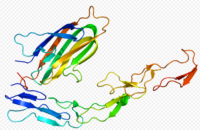
Hideo Asada, MD, PhD
Department of Dermatology
Nara Medical University
It has long been a mystery why HHV-6 preferentially reactivates in drug reaction with eosinophilia and systemic symptoms (DRESS), also known as drug induced hypersensitivity syndrome (DIHS). HHV-6 reactivation occurs in over 60% of severe cases and is in fact part of the definition of DIHS in Japan.
A group from Nara Medical University in Japan has determined that the culprit responsible for the high rates of HHV-6 infection seen in these hypersensitivity disorders may be CD134, a member of the tumor necrosis factor receptor superfamily (TNFRS4) that is also known as OX40. CD134/OX40 is a co-stimulatory molecule that is transiently expressed on activated CD4 and CD8 T cells. The receptor also plays a key role in Th1 and Th2 mediated reactions, as well as in the cytokine storm associated with certain viral infections.
Since CD134 was recently discovered to be the receptor that allows HHV-6B entry into cells (Tang 2013), the Nara University group, led by Dr. Hideo Asada, sought to determine whether CD134 was over-expressed in DIHS/DRESS cases compared to other hypersensitivity syndromes.
The group found that the patients acutely ill with DIHS showed CD134 positivity in 23% of CD4 T cells compared to only 7% in Stevens Johnson Syndrome patients and 4% in those with maculopapular rash. They determined that the CD4 T cells were activated equally in all three skin conditions, but CD134 was only upregulated in the DIHS/DRESS patients. In addition, they found that CD134 was upregulated during the early phase of DIHS and substantially reduced in the late phase.
The authors conclude that CD4 T cells play an important role in the pathogenesis of DIHS and facilitate the spread of HHV-6. They also posit that upregulation of CD134 may serve as a biomarker for DIHS/DRESS. Previous studies have shown that DIHS/DRESS is associated with an antiviral CD8+T cell response (Picard 2010).
French dermatologist Vincent Descamps has called for antiviral therapy to be given in conjunction with steroids in severe DRESS/DIHS and suggests that the condition might be more aptly named “VRESS” for Virus Reactivation with Eosinophilia and Systemic Symptoms” (Descamps 2013).
Of interest, high dose steroids increase HHV-6 viral loads in DRESS/DIHS dramatically; in contrast, steroids have only a minor impact on CMV and no impact on EBV viral load, according to a Japanese group of dermatologists (Ishida 2014).
A group in Japan has proposed another theory to explain why the CD4 cells become infected so quickly in DIHS/DRESS. They note that HMGB-1 released from damaged skin chemoattracts HHV-6 infected monomyeloid precursor cells to the skin where they interact with CD4 cells, which are then infected. (Hashizume 2013).
Selective depletion of CD134 in transplant patients reduces the risk of GVHD (Ge 2008), and HHV-6 has been found in recent studies to be an important predictor of GVHD (Verhoeven 2015).
For more information on the study, read the full text (Miyagawa 2016). Also, visit the HHV-6 Foundation’s webpage on HHV-6 & Drug Hypersensitivity.

